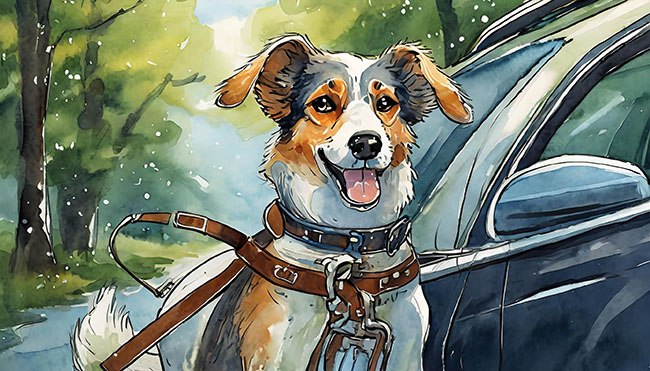
Dog harness design has come a long way. Initially, harnesses were basic strap systems meant to secure working dogs. However, the need for more sophisticated designs grew as society’s relationship with dogs evolved. Modern harnesses are now ergonomic, reduce strain, prevent injury, and increase handler control. They are also preferred alternatives to traditional collars, recommended by veterinary professionals and dog trainers.
The Anatomy of a Dog Harness
A good dog harness distributes pressure and weight evenly across the chest and back, minimizing strain on the neck. There are three main types of harnesses: back-clip, front-clip, and dual-clip. Materials used in harness construction play a significant role in the harness’s durability, weight, and comfort. Many harnesses feature adjustable straps to ensure the perfect fit. A well-fitting harness negates the risk of the dog slipping out or suffering from rubbing during walks and activities.
Different Types of Dog Harnesses
Dog harnesses come in various styles, each designed with specific purposes, breeds, and activities in mind. Here are some common types of dog harnesses:
- Flat or Standard Harnesses: These are the most common types of harnesses, suitable for small to medium-sized dogs. They distribute force across the chest and back, reducing strain on the neck.
- No-Pull Harnesses: Designed to discourage pulling by applying gentle pressure through straps that tighten slightly when the dog pulls. These often have a front clip for the leash. How Do No-Pull Dog Harnesses Work?
- Step-In Harnesses: As the name suggests, dogs can step into these harnesses, which then buckle or clip over their back. Great for dogs who don’t like harnesses going over their head.
- Padded Harnesses: These harnesses have extra padding to provide additional comfort for the dog, especially useful for breeds with shorter fur or for use during extended periods of wear.
- Vest Harnesses: Made of a larger piece of material that covers more of the dog’s body. They often have padding for comfort and can provide extra warmth in colder weather.
- Roman Harnesses: These have a design that crisscrosses over the back and under the belly, offering good support and control, suitable for a variety of dog sizes.
- Tactical Harnesses: Built for working dogs or for outdoor activities, these are made from durable materials and often feature attachments for gear and patches.
- Head Halters: While not a harness for the body, head halters are used for training and control, fitting around the dog’s head and nose. They provide control over the dog’s direction, making them useful for dogs that pull.
- Lift-and-Assist Harnesses: Designed for elderly, injured, or disabled dogs, these harnesses provide a way to assist dogs in standing, climbing stairs, or getting into vehicles. They typically feature handles or straps for lifting.
- Car Safety Harnesses: These are designed to keep dogs safe while traveling in a vehicle. They are often crash-tested and can be secured using the car’s seatbelt system.
Each type of harness has its benefits, and the right choice depends on your dog’s size, behavior, and the activities you plan to do together. It’s important to ensure a proper fit to prevent escape and to avoid any discomfort or injury to your dog.
Ergonomics and Adjustability
Modern dog harnesses are designed based on ergonomics, which ensures comfort and reduces the risk of injury by complementing the dog’s natural movements. Different shapes and sizes of dogs require a tailored fit, provided by multiple adjustment points and features like sliders, buckles, and hook-and-loop fasteners. A well-fitted harness is comfortable and safe, as a tight harness can impede movement and breathing. In contrast, a loose harness can increase escapability and the risk of accidents. Fine-tuning the fit is a responsible investment in your pet’s well-being.
Safety Features in Modern Dog Harnesses
Pet owners prioritize safety features in harness design. Reflective materials and heavy-duty buckles provide added safety. The choice of materials is crucial for longevity and resilience. Locking buckles and reinforced attachment points mitigate the dog’s risk of breaking free. These features assure pet owners that their furry friends will remain securely by their side.
Comfort: A Priority for Pet Owners
A comfortable harness is crucial for a dog’s enthusiasm and enjoyment of walk. Padding in strategic areas and breathable materials can help reduce discomfort. When dogs feel comfortable in their harness, they are more cooperative and focused on walks and training sessions. A well-designed harness can make a positive difference for the dog and the owner.
Harness Training for Dogs
Harness training is essential for dogs. Initially, let them sniff and become familiar with the harness without putting it on. Once they are comfortable, wear them indoors and outdoors for short periods. Harness training results in a safer and more comfortable outdoor experience and fosters trust in the equipment and the handler.
Choosing the Right Harness for Your Dog
Selecting the appropriate harness for your dog is crucial to ensure their comfort and safety. Consider your dog’s breed, size, activity level, and behavioral issues. Accurate measurement is crucial measure the widest part of the chest and add a few inches for flexibility. Experimentation may be required to find the perfect fit. Read reviews and research different brands and models to help make an informed decision.
Maintaining and Caring for Your Dog’s Harness
To ensure your dog’s harness lasts long, regularly inspect it for signs of wear and clean it after muddy or wet outings. Follow the manufacturer’s cleaning instructions to avoid damage. Replace the harness if the fit is loose or there is visible damage. Store the harness in a dry and cool place when not in use. It will help to ensure the harness is reliable and safe for your dog.
Innovations on the Horizon for Dog Harnesses
Dog harness design is set for remarkable innovation, focusing on technology integration, sustainable materials, customization, and enhanced well-being. With this knowledge, we can confidently equip our dogs with harnesses that serve their functional needs and support their happiness and well-being.



